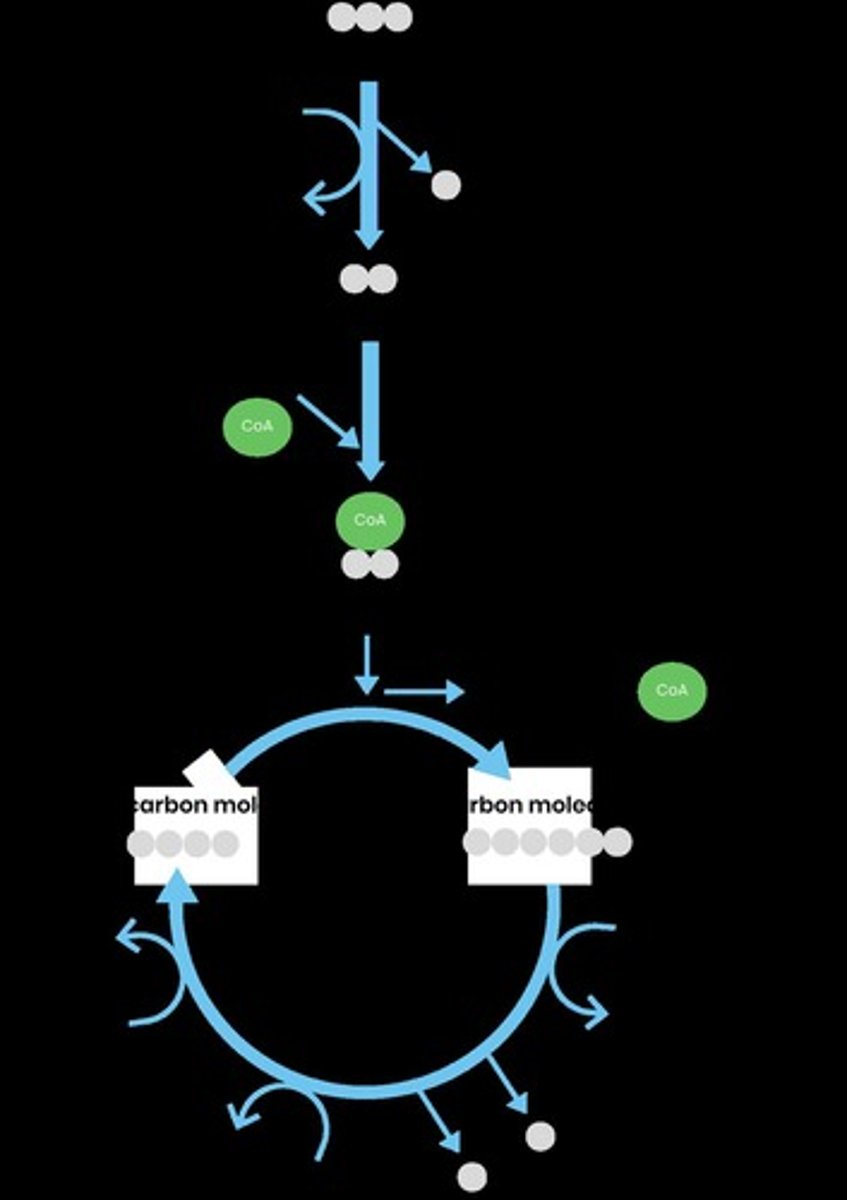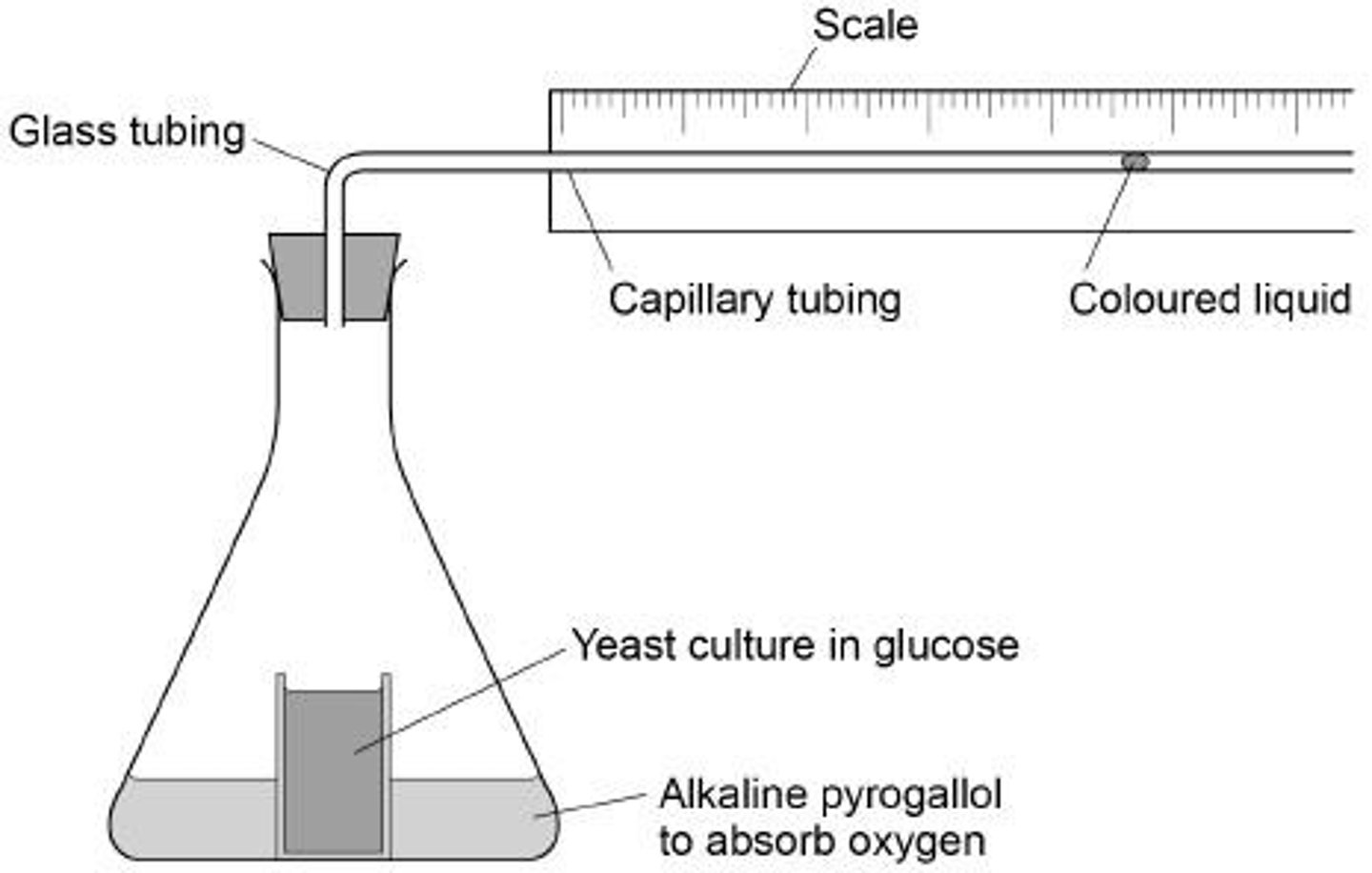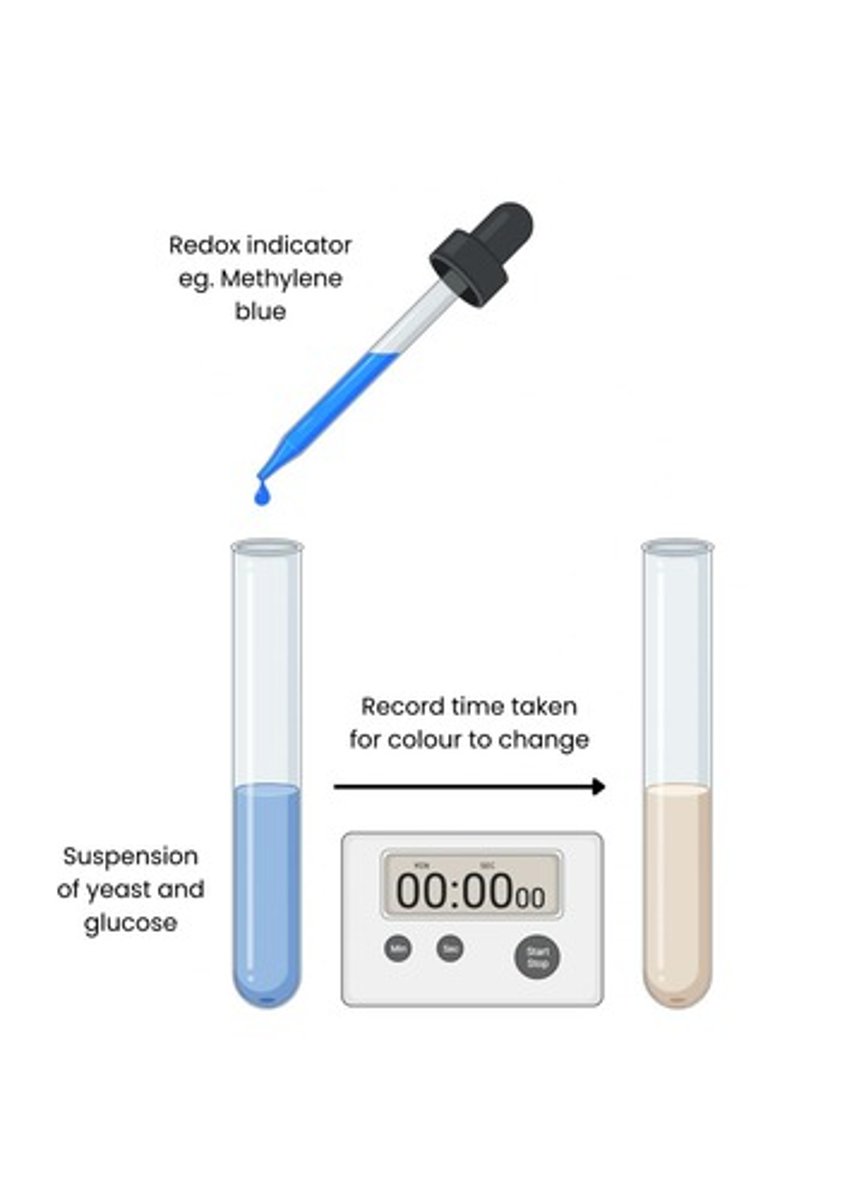AQA A Level Biology: Energy Transfers in Organisms
1/136
There's no tags or description
Looks like no tags are added yet.
Name | Mastery | Learn | Test | Matching | Spaced |
|---|
No study sessions yet.
137 Terms
Light dependent reaction
Occurs in the thylakoid membrane of chloroplast.

Light independent reaction
Occurs in the stroma of chloroplast.
Photoionisation
Chlorophyll absorbs light energy which excites its electrons, causing electrons to be released from chlorophyll.
Chemiosmotic theory
Describes how energy from electrons is used to actively pump protons from stroma into thylakoid, creating an electrochemical gradient.
Photophosphorylation
Energy is used to join ADP and Pi to form ATP.
Photolysis of water
Water splits to produce protons, electrons, and oxygen (H2O → ½ O2 + 2e-).
Calvin cycle
The light-independent reaction where CO2 reacts with ribulose bisphosphate (RuBP) to form glycerate 3-phosphate (GP).

Rubisco
The enzyme that catalyses the reaction between CO2 and ribulose bisphosphate (RuBP).
Glycerate 3-phosphate (GP)
The molecule formed when CO2 reacts with RuBP.
Triose phosphate (TP)
The product formed from the reduction of GP using reduced NADP and energy from ATP.
Effect of temperature on photosynthesis
As temperature increases, the rate of photosynthesis increases until an optimum temperature is reached, after which the rate decreases due to enzyme denaturation.
Effect of light intensity on photosynthesis
As light intensity increases, the rate of photosynthesis increases until another factor becomes limiting.
Effect of CO2 concentration on photosynthesis
As CO2 concentration increases, the rate of photosynthesis increases until another factor becomes limiting.
Agricultural practices
Should increase the rate of photosynthesis to enhance yield, but profits must outweigh costs.
Enzyme-substrate complexes
Formed when enzymes gain kinetic energy, increasing the rate of reactions.
Limiting factor
A factor that limits the rate of a process, such as photosynthesis, when it reaches a certain level.
ATP
A molecule that provides energy for cellular processes, formed during photophosphorylation.
Reduced NADP
Formed when NADP accepts a proton and an electron during the light-dependent reactions.
Electrochemical gradient
Created when protons are pumped into the thylakoid space, driving ATP synthesis.
Glucose
A product of the Calvin cycle, formed from triose phosphate (TP).
Kinetic energy
Energy that enzymes gain as temperature increases, leading to more enzyme-substrate complexes.
Denaturation
The process where enzymes lose their functional shape due to high temperatures, reducing the rate of reactions.
Facilitated diffusion
The process by which protons move down their electrochemical gradient into the stroma via ATP synthase.
NADP
A coenzyme used in photosynthesis that transfers electrons.
NAD / FAD
Coenzymes used in respiration that transfer electrons.
Electron Transfer Chain (ETC)
A series of proteins that allow protons to be pumped into the thylakoid, creating a gradient.
Chemiosmosis
The process driven by a proton gradient that produces ATP.
GP
Glucose phosphate, specifically glycerate 3-phosphate.
TP
Triose phosphate, which must be written in full before using the abbreviation.
Chromatography
A method used to investigate pigments isolated from leaves of different plants.
Pigment Isolation Steps
1. Crush leaves with solvent to extract pigments. 2. Draw a pencil line on filter paper. 3. Add a drop of extract to line. 4. Stand paper in boiling tube of solvent. 5. Add lid and leave to run. 6. Remove before solvent reaches top and mark solvent front.
Point of Origin
The location on chromatography paper where the pigment extract is applied.
Solvent Front
The highest point reached by the solvent in chromatography, which should be marked quickly.
Rf Value
The ratio of the distance moved by a pigment spot to the distance moved by the solvent front.
Dehydrogenase
An enzyme that catalyses the reduction of NADP in the light-dependent reaction of photosynthesis.
DCPIP
A redox indicator dye used to measure dehydrogenase activity.
Control 1
A test tube setup with DCPIP, water, and chloroplasts in isolation medium covered in foil.
Control 2
A test tube setup with DCPIP, water, and isolation medium without chloroplasts.
Standard
A test tube setup with water and chloroplasts in isolation medium without DCPIP.
Experiment
A test tube setup with DCPIP, water, and chloroplasts in isolation medium.
Endpoint Identification
Comparing the color change of DCPIP to a color standard to identify the endpoint.
Light Exposure
Shining light on test tubes to initiate the reaction and measure the time for DCPIP to turn colorless.
Chloroplast Extraction
The process of obtaining chloroplasts from leaf samples for experimentation.
Solvent Solubility
A reason why a pigment may not move up the chromatography paper in one solvent.
Standardizing Readings
Measuring the center of each pigment spot to allow for comparisons.
Running Conditions
Factors that may affect Rf values, leading to similar but not identical results compared to published values.
Rate of dehydrogenase activity
1 / time taken (s-1)
Control 1 purpose
Shows light is required for DCPIP to decolourise; shows that chloroplasts alone do not cause DCPIP to decolourise.
Control 1 explanation
No light so no photoionisation of chlorophyll; so no electrons released to reduce DCPIP.
Control 2 purpose
Shows chloroplasts are required for DCPIP to decolourise; shows that light alone does not cause DCPIP to decolourise.
DCPIP colour change explanation
: DCPIP is a redox indicator / DCPIP gets reduced by electrons from photoionisation of chlorophyll.
Method limitation
End point (colour change) is subjective.
Method modification
Use a colorimeter to measure light absorbance of sample at set time intervals; zero colorimeter using the colour standard.
Importance of respiration
Respiration produces ATP (to release energy) for active transport, protein synthesis etc.
Stages of aerobic respiration
1. Glycolysis - cytoplasm; 2. Link reaction - mitochondrial matrix; 3. Krebs cycle - mitochondrial matrix; 4. Oxidative phosphorylation - inner mitochondrial membrane.

Stages of anaerobic respiration
1. Glycolysis - cytoplasm; 2. NAD regeneration - cytoplasm.
Glycolysis process
1. Glucose phosphorylated to glucose phosphate using inorganic phosphates from 2 ATP; 2. Hydrolysed to 2 x triose phosphate; 3. Oxidised to 2 pyruvate (2 NAD reduced; 4 ATP regenerated (net gain of 2)).
Anaerobic respiration after glycolysis
1. Pyruvate converted to lactate (animals & some bacteria) or ethanol (plants & yeast); 2. Oxidising reduced NAD → NAD regenerated; 3. So glycolysis can continue (which needs NAD) allowing continued production of ATP.
ATP production in anaerobic respiration
Only glycolysis involved which produces little ATP (2 molecules); no oxidative phosphorylation which forms majority of ATP (around 34 molecules).
Aerobic respiration after glycolysis
Pyruvate is actively transported into the mitochondrial matrix.
Link reaction process
1. Pyruvate oxidised (and decarboxylated) to acetate (CO2 produced, reduced NAD produced); 2. Acetate combines with coenzyme A, forming Acetyl Coenzyme A. Products per glucose molecule: 2 x Acetyl Coenzyme A, 2 x CO2 and 2 x reduced NAD.
Krebs cycle process
1. Acetyl coenzyme A (2C) reacts with a 4C molecule (releasing coenzyme A, producing a 6C molecule that enters the Krebs cycle); 2. In a series of oxidation-reduction reactions, the 4C molecule is regenerated and: 2 x CO2 lost, coenzymes NAD & FAD reduced, substrate level phosphorylation → ATP produced. Products per glucose molecule: 6 x reduced NAD, 2 x reduced FAD, 2 x ATP and 4 x CO2.
Oxidative phosphorylation process
1. Reduced NAD/FAD oxidised to release H atoms → split into protons (H+) and electrons (e-); 2. Electrons transferred down electron transfer chain (chain of carriers at decreasing energy levels) by redox reactions; 3. Energy released by electrons used in the production of ATP from ADP + Pi (chemiosmotic theory): Energy used by electron carriers to actively pump protons from matrix → intermembrane space; Protons diffuse into matrix down an electrochemical gradient, via ATP synthase (embedded), releasing energy to synthesise ATP from ADP + Pi.

Final electron acceptor
Oxygen is the final electron acceptor in the electron transport chain.
Water formation in respiration
Protons, electrons, and oxygen combine to form water.
Respiratory substrates
Breakdown products of lipids and amino acids that enter the Krebs cycle.
Fatty acids conversion
Fatty acids from hydrolysis of lipids are converted to Acetyl Coenzyme A.
Amino acids conversion
Amino acids from hydrolysis of proteins are converted to intermediates in the Krebs cycle.
Glycolysis
The first stage of both aerobic and anaerobic respiration.
NAD/FAD
NAD and FAD are coenzymes used in respiration to transfer electrons.
Triose phosphate
Triose phosphate is oxidised to produce pyruvate in glycolysis.
Krebs cycle
The Krebs cycle produces reduced NAD/FAD, which pass electrons to the electron transfer chain.
Oxidation and reduction
'OIL RIG' - oxidation is loss of electrons, reduction is gain.
Proton movement
Protons move across the inner mitochondrial membrane into the intermembrane space.
Respirometer function
Measures O2 uptake to assess the rate of aerobic respiration.

Respirometer procedure
Add a set mass of single-celled organism to a set volume/concentration of substrate.
Buffer in respirometer
A buffer is added to keep pH constant during the respiration measurement.
Chemical absorption in respirometer
A chemical that absorbs CO2, such as sodium hydroxide, is added.
Temperature control
Place the respirometer in a water bath at a set temperature and allow to equilibrate.
Liquid movement explanation
The liquid moves due to a decrease in gas volume and pressure in the container.
Airtight apparatus
The apparatus must be airtight to prevent changes in volume and pressure.
Gas syringe usage
A gas syringe can be used for a more accurate measurement of gas volume.
Rate of respiration calculation
Calculate volume of O2/CO2 consumed/released, divide by mass of organism and time taken.
Units for respiration rate
Units are volume per unit time per unit mass, e.g., cm³ min⁻¹ g⁻¹.
Anaerobic respiration measurement
Measures CO2 release by removing the chemical that absorbs CO2.
Anaerobic conditions
Make conditions anaerobic by layering oil above yeast to stop O2 diffusion.
Yeast anaerobically respire
Release CO2
Volume of gas and pressure in container
Increase due to yeast respiration
Fluid in capillary tube
Moves down a pressure gradient away from organism
Apparatus left for an hour
Allows time for oxygen to be used / respired
Redox indicator dyes
Change colour when they accept electrons, becoming reduced
Redox indicators
Take up hydrogens and get reduced instead of NAD / FAD
Rate of respiration (s^-1)
Calculated as 1 / time (sec)
Controlled variables in respiration experiment
Volume of single-celled organism, volume/concentration/type of respiratory substrate, temperature, pH, volume of redox indicator
Tubes left in water bath for 5 minutes
Allows for solutions to equilibrate and reach the same temperature as the water bath
Control experiment with methylene blue
Add methylene blue to boiled/inactive/dead yeast to show change is due to respiration in organisms

Shaking tubes containing methylene blue
Must not shake as it would mix solution with oxygen, oxidising methylene blue
Source of error using methylene blue
Subjective determination of colour change; can be reduced by comparing results to a colour standard or using a colorimeter
Biomass formation in plants
Plants make organic (carbon) compounds from atmospheric or aquatic CO2 during photosynthesis
Measurement of biomass
Mass of carbon or dry mass of tissue per given area